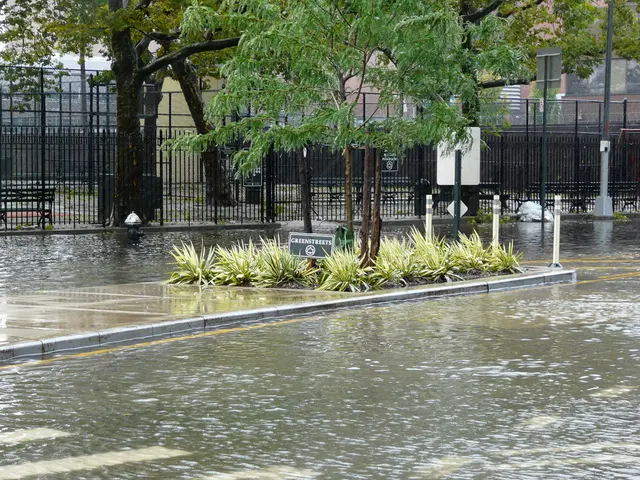B-52 Bombers Dispatched to Middle East as a Deterrent against Iran, with Additional F-15E Fighters En route
Bombers Touch Down in the Middle East: B-52s Return after a Two-Year Absence
It's back to business as usual in the Middle East, with the U.S. Air Force bringing in some heavy-hitters - the iconic B-52 Stratofortress bombers. On November 3, these war horses made their long-awaited return to the region, marking their first deployment here since 2019.
The U.S. decided to beef up its presence with a total of six B-52s, a squadron of F-15E Strike Eagles, and additional aerial refueling tankers, as disclosed by U.S. officials to Air & Space Forces Magazine.
This latest show of force is primarily aimed at compensating for the imminent departure of the USS Abraham Lincoln carrier strike group. Simultaneously, it's a response to escalating threats from senior Iranian officials, who've vowed retaliation against Israel following their airstrikes on Iranian air defenses and missile production sites on October 26.
In a statement on November 1, Pentagon Press Secretary Air Force Maj. Gen. Patrick S. Ryder explained, "These movements reflect the versatile nature of U.S. global defense posture and our capacity to deploy worldwide promptly to address evolving national security challenges."
Although the final location for the B-52s, hailing from the 5th Bomb Wing at Minot Air Base, N.D., remains undisclosed, cargo planes from the same base have recently touched down at Al Udeid Air Base, Qatar. Known as the largest U.S. base in the Middle East, Al Udeid has previously hosted B-52s during deployments.
The Lincoln battlegroup consists of warships equipped to thwart ballistic missiles. Previously, the U.S. cruisers and destroyers' weaponry helped shield Israel from Iranian ballistic missiles in April and October. U.S. Secretary of Defense Lloyd J. Austin III has now ordered more missile defense-capable destroyers to the region, with these forces due to arrive in the coming months.
In recent weeks, the Pentagon has taken numerous steps to reinforce its military stance in the region. Last month, a Terminal High Altitude Area Defense (THAAD) ballistic missile defense system made its debut in Israel, accompanied by nearly 100 U.S. troops to operate it. Almost 2,000 Marines are currently stationed in the eastern Mediterranean as part of an Amphibious Ready Group Marine Expeditionary Unit (ARG/MEU) led by the USS Wasp amphibious assault ship.
A fresh squadron of F-16s, the 480th Fighter Squadron from Spangdahlem Air Base, Germany, touched down in the Middle East in late October. KC-46 Pegasus tankers preceded Austin's order for additional airpower in the region, deploying to CENTCOM in early October.
Secretary Austin made the decision to deploy the B-52s and other assets "in line with our commitments to safeguard U.S. citizens and forces in the Middle East, shield Israel, and encourage de-escalation through deterrence and diplomacy," Ryder revealed. "Secretary Austin emphasizes that should Iran, its allies, or its proxies use this opportunity to target American personnel or interests in the region, the United States will employ every available measure to shield our people."
AirNational Security
The B-52 Stratofortress has a long history of deployment in the Middle East, dating back to operations during the Iraq War and those against ISIS. For current or recent deployment details, it's recommended to consult official military or defense news sources.
- The Rise of Military Presence: The U.S. Air Force, resuming its heavy-duty role, has brought back B-52 Stratofortress bombers, typically associated with war and conflicts, to bolster defenses in the Middle East.
- Preparing for Potential Conflicts: In response to emerging security threats and escalating tensions, a squadron of F-15E Strike Eagles, additional aerial refueling tankers, and six B-52s are being deployed, according to U.S. officials.
- Combating Missile Threats: The imminent departure of the USS Abraham Lincoln carrier strike group is being compensated by the deployment of more missile defense-capable destroyers, delivering extra security in the space domain.
- Fortifying Global Defense Network: The U.S. demonstrates its versatile global defense posture with prompt deployments of assets, ensuring preparedness for diverse national security challenges across space, military, and air force domains.
- The Role of Space and Air Force in Security: The B-52s, hailing from Minot Air Base, N.D., are anticipated to touch down at Al Udeid Air Base, a move that underscores the importance of air and space force in securing U.S. interests in the region.
- New Sentries Take Position: As recent developments unfold, fresh squadrons like the F-16s and KC-46 Pegasus tankers are assuming their posts in the Middle East amid heightened political tensions.
- Deterrence and Diplomacy: Secretary Austin's decision to deploy the B-52s and other assets is a calculated strategy aimed at safeguarding U.S. citizens, shielding allies like Israel, encouraging de-escalation, and maintaining a general stance of deterrence and diplomacy in the face of regional conflicts.






